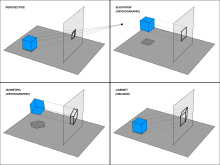
A | B | C | D | E | F | G | H | CH | I | J | K | L | M | N | O | P | Q | R | S | T | U | V | W | X | Y | Z | 0 | 1 | 2 | 3 | 4 | 5 | 6 | 7 | 8 | 9
| Part of a series on |
| Graphical projection |
|---|
 |
Orthographic projection (also orthogonal projection and analemma)[a] is a means of representing three-dimensional objects in two dimensions. Orthographic projection is a form of parallel projection in which all the projection lines are orthogonal to the projection plane,[2] resulting in every plane of the scene appearing in affine transformation on the viewing surface. The obverse of an orthographic projection is an oblique projection, which is a parallel projection in which the projection lines are not orthogonal to the projection plane.
The term orthographic sometimes means a technique in multiview projection in which principal axes or the planes of the subject are also parallel with the projection plane to create the primary views.[2] If the principal planes or axes of an object in an orthographic projection are not parallel with the projection plane, the depiction is called axonometric or an auxiliary views. (Axonometric projection is synonymous with parallel projection.) Sub-types of primary views include plans, elevations, and sections; sub-types of auxiliary views include isometric, dimetric, and trimetric projections.
A lens that provides an orthographic projection is an object-space telecentric lens.
Geometry



A simple orthographic projection onto the plane z = 0 can be defined by the following matrix:
For each point v = (vx, vy, vz), the transformed point Pv would be
Often, it is more useful to use homogeneous coordinates. The transformation above can be represented for homogeneous coordinates as
For each homogeneous vector v = (vx, vy, vz, 1), the transformed vector Pv would be
In computer graphics, one of the most common matrices used for orthographic projection can be defined by a 6-tuple, (left, right, bottom, top, near, far), which defines the clipping planes. These planes form a box with the minimum corner at (left, bottom, -near) and the maximum corner at (right, top, -far).[3]
The box is translated so that its center is at the origin, then it is scaled to the unit cube which is defined by having a minimum corner at (−1,−1,−1) and a maximum corner at (1,1,1).
The orthographic transform can be given by the following matrix:
which can be given as a scaling S followed by a translation T of the form
Antropológia
Aplikované vedy
Bibliometria
Dejiny vedy
Encyklopédie
Filozofia vedy
Forenzné vedy
Humanitné vedy
Knižničná veda
Kryogenika
Kryptológia
Kulturológia
Literárna veda
Medzidisciplinárne oblasti
Metódy kvantitatívnej analýzy
Metavedy
Metodika
Text je dostupný za podmienok Creative
Commons Attribution/Share-Alike License 3.0 Unported; prípadne za ďalších
podmienok.
Podrobnejšie informácie nájdete na stránke Podmienky
použitia.
www.astronomia.sk | www.biologia.sk | www.botanika.sk | www.dejiny.sk | www.economy.sk | www.elektrotechnika.sk | www.estetika.sk | www.farmakologia.sk | www.filozofia.sk | Fyzika | www.futurologia.sk | www.genetika.sk | www.chemia.sk | www.lingvistika.sk | www.politologia.sk | www.psychologia.sk | www.sexuologia.sk | www.sociologia.sk | www.veda.sk I www.zoologia.sk





